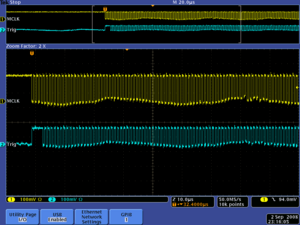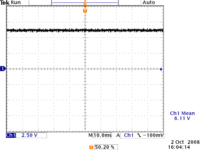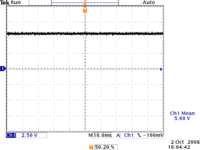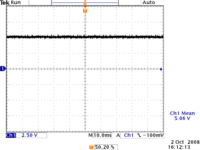Difference between revisions of "Readout Electronics"
| Line 442: | Line 442: | ||
s3610VFATclock(0,64575) | s3610VFATclock(0,64575) | ||
| + | |||
| + | |||
| + | Turn on the VFAT (sleepb on) | ||
| + | |||
| + | echo "p 64 0 off" | ./flipbit.arm | ||
Revision as of 15:13, 16 April 2009
I/O
Inputs to breakout box
- Trigger (LVDS)
- Clock ( RF synced pulse 31 MHz = 499/16 MHz, LVDS)
- Flip Flop scaner (1 TTL pulse)
V1495 :
- 28 Pin output on 34 pin ribbon cables
- Inputs to V1495:
- 180 bits of data = 12 bits Bunch Counter ( =31 MHz clock) + 12 bit (Event Counter + flags) + 12 bits (Chip ID) + 128 bits (data) + 16 bits (Checksum)
- The input register has been set to a size of 256 bit and there are 12 of them
Timing
- VFAT:
- Progammable through the Latency register (8 bits = 256 bits) you have but only 128 registers data registers. We can go back in time 100 *32 ns = 3 micro seconds. But we only may need 100 ns.
V1495: can have programmable delay up to?
We can program delays and play with the timing by downloading values for "lat" into the VFAT extended register and set delay on the V1495 through the ROC.
The V1495 can also interupt the VME backplane telling a ROC to readout the planes.
FPGA to VME data transfer
On 2/15/07 Ben Raydo tested the read and write speeds between the VPM backplane and the FPGA user registers. He was able to write 16 bits to USER FPGA in 330 ns.
VFAT controls
Brian Oborn: 282- 6243
VFAT control registers
Control register 0
| bit | bit name | Function |
| 0 | Sleep/Run | 0 = sleep, 1=run also reffereed to as sleep blocking |
Control Register 1
Control register 2
VFAT Clock and Trig pulses
The Clock and Trigger LVDS pulses for the VFAT board were generated using the SIS3610 I/O register. I simply wrote bits to the register. The I/O registers internal clock then determine the pulse frequency. I set the bits to be 1110000000000000 using the command
s3610VFATclock(0,57344);
and reset all bits to zero except for the trigger input (100000000000000 b = 16384 d )which remained high for the first 3 clock pulses by hardwiring the value 16384 in the SIS3610 library function call. According to Table 2 in the VFAT manual from July 2006, leaving the first 3 bits high tells the VFAT board to operate in "CalPulse" mode..
void s3610VFATclock(int id, unsigned int val)
{
int i;
if((id<0) || (s3610p[id] == NULL)) {
logMsg("s3610WriteOutput: ERROR : SIS3610 id %d not initialized \n",id,0,0,0,0,0);
return;
}
s3610p[id]->d_out = val;
s3610p[id]->d_out = 16384;
s3610p[id]->d_out = val;
s3610p[id]->d_out = 16384;
s3610p[id]->d_out = val;
s3610p[id]->d_out = 16384;
for(i=0;i<200;i++)
{
s3610p[id]->d_out = val;
s3610p[id]->d_out = 0;
}
logMsg("s3610VFATclock: Finish pulses \n",id,0,0,0,0,0);
return;
}
The third highest bit was used to drive the scope.
To use the above function you need to be sure the SIS3610 is initialized by typing in the ROC communication window (telnet roc1)
-> s3610Init 0x3800 Initialized SIS3610 ID 0 at address 0x91003800 value = 0 = 0x0
The just execute the function
-> s3610VFATclock(0,57344); 0xdc79380 (tShell): s3610VFATclock: Finish pulses value = 32 = 0x20 = ' '
Then using the Gumstick command line set the DFtest pattern bit via I2C
Turn on the VFAT
# pwd /root/bin # ./run.arm
set the DF test pattern bit
# echo "e 134 4 on" | flipbit.arm Using mode e Using address 134 Using bit 4 Using action on
Then in the ROC window exectue the VFAT clockpulse function
-> s3610VFATclock(0,57344); 0xdc79380 (tShell): s3610VFATclock: Finish pulses value = 32 = 0x20 = ' '
You should see the picture above
Put the VFAT back into sleep mode
# ./sleep_on.arm
Cal pulse Procedure
Check that VCAL connects to DACo
1.) First set up the following values for operating the chip
| Register | Value |
| ContReg0 | 9 d = 1001 b |
| ContReg1 | 128 d = 10000000 b |
| IPreampIn | 142d = 10001110 b |
| IPreampFeed | 70 d = 1000110 b |
| IPreampOut | 130 d = 10000010 b |
| IShaper | 127 d = 1111111 b |
| IShaperFeed | 85 d = 1010101 b |
| IComp | 100 d = 1100100 b |
| vcal | 128 d = 10000000 b |
| Vthreshold1 | 0 |
| Vthreshold2 | 15 d = 1111 b |
1.) Connect VCal to DACo-V by setting DACsel = 1001
echo "p 65 0 on p 65 1 off p 65 2 off p 65 3 on" | flipbit.arm
2.) set calibration mode to output VCal values by setting CalMode = 01
echo "p 64 6 on p 64 7 off p " | flipbit.arm
3.) set VCAL
this turns one of the 8 bits to the calibration voltage Vcal (It ranges from 1.074 to 0.877 Volts)
echo "e 129 1 on" | flipbit.arm
4.) Look for a voltage on the output connector pin #162 which corresponds to pin B4 on the ribbon cable connector.
I see the following on the scope when I set VCAL to zero
echo "e 129 7 off" | flipbit.arm
I see the following when I set the highest bit to VCAL (VCAL = 1000000 b = 128 d)
echo "e 129 7 on" | flipbit.arm
I see the following when I set the highest bit to VCAL (VCAL = 1111111 b = 255 d)
echo "e 129 7 on" | flipbit.arm
| VCAL | DC Level |
| 0 | 6.11 |
| 128 | 5.6 |
| 255 | 5.06 |
The VFAT2 manual states that VCAL should range between 1.074 to 0.877 Volts. I observe on the scope that the B4 pin output (VCAL) changes from 6.11 to 5.06 Volts when terminated in 1 M Ohm (High -Z).
I see the voltage difference between the min and max VCAL setting is 1.05 Volts. Perhaps this is what the manual refers to as the VCAL range?
VCAL baseline
The second step is to measure the baseline for each VCal DAC setting by changing calmode to (CalMode<1> =1 and clamod<0>=0). Above we had CalMode<1> =1 and CalMode<0>=1.
echo "p 64 6 off p 64 7 on p " | flipbit.arm
| VCAL | DC Level |
| 0 | 6.12 |
| 128 | 5.6 |
| 255 | 5.06 |
I see similar voltage on DAC-0 when I look at the baseline.
When I put the VFAT into sleep mode I see 26 mV on the output.
Setting Thresholds
The registers VThreshold1 and VThreshold2 are used to set the threshold on the analog input. The actual threshold applied is given by the difference (VTheshold2 -Vthreshold1) in order to have the ability to set positive and negative thresholds. A negative threshold (for the GEM output signal) can be set by having VThreshold2 =0 and VThreshold1>0.
Using VCAL to test output digitization
You can use VCal to inject a pulse into the channels via the CalChan1 bit on each channel. You need to be sure CalPolarity is consistent with (VTheshold2-VThreshold1).
I have a scipt to setup the VFAT parameters call cal.setup
from the gumstick console type the following within the /user/bin subdirectory:
# flipbit.arm < cal.setup
The web interface to the VFAT looked like
| ContReg<0> | 64 | 9 | 9 | ||||
| CalMode<1> | CalMode<0> | CalPolarity | MSPolarity | Trigmode<2> | Trigmode<1> | Trigmode<0> | Sleepb |
| Off | Off | Off | Off | On | Off | Off | On |
| ContReg<1> | 65 | 80 | 128 | ||||
| ReHitCT<1> | ReHitCT<0> | LVDSPowerSave | ProbeMode | DACsel<3> | DACsel<2> | DACsel<1> | DACsel<0> |
| On | Off | Off | Off | Off | Off | Off | Off |
| IPreampIn | 66 | 8e | 142 | ||||
| IPreampFeed | 67 | 46 | 70 | ||||
| IPreampOut | 68 | 82 | 130 | ||||
| IShaper | 69 | 7f | 127 | ||||
| IShaperFeed | 70 | 55 | 85 | ||||
| IComp | 71 | 64 | 100 | ||||
| ChipID<0> | 72 | f3 | 243 | ||||
| ChipID<1> | 73 | ee | 238 | ||||
| UpsetReg | 74 | 0 | 0 | ||||
| HitCount0 | 75 | 0 | 0 | ||||
| HitCount1 | 76 | 0 | 0 | ||||
| HitCount2 | 77 | 0 | 0 | ||||
| ExtRegPointer | 78 | 6 | 6 | ||||
| ExtRegData | 79 | 0 | 0 | ||||
| Lat | 0 | 0 | 0 | ||||
| VCal | 129 | 80 | 128 | ||||
| VThreshold1 | 130 | 0 | 0 | ||||
| VThreshold2 | 131 | f | 15 | ||||
| CalPhase | 132 | 0 | 0 | ||||
| ContReg<2> | 133 | 70 | 112 | ||||
| DigInSel | MSPulseLength<2> | MSPulseLength<1> | MSPulseLength<0> | HitCountSel<3> | HitCountSel<2> | HitCountSel<1> | HitCountSel<0> |
| Off | On | On | On | Off | Off | Off | Off |
| ContReg<3> | 134 | 5 | 5 | ||||
| - | - | - | DFTestPattern | PbBG | TrimDACrange<2> | TrimDACrange& lt;1> | TrimDACrange<0> |
| Off | Off | Off | Off | Off | On | Off | On |
| Spare<135> | 135 | ef | 239 | ||||
| ChanReg<1> | 1 | 10 | 16 | ||||
| CalChan0 | CalChan1 | Mask | TrimDAC<4> | TrimDAC<3> | TrimDAC<2 > | TrimDAC<1> | TrimDAC<0> |
| Off | Off | Off | On | Off | Off | Off | Off |
| ChanReg<2> | 2 | d0 | 208 | ||||
| CalChan1 | Mask | TrimDAC<4> | TrimDAC<3> | TrimDAC<2> | TrimDAC<1> | TrimDAC<0> | |
| On | On | Off | On | Off | Off | Off | Off |
| ChanReg<3> | 3 | 80 | 128 | ||||
| CalChan1 | Mask | TrimDAC<4> | TrimDAC<3> | TrimDAC<2> | TrimDAC<1> | TrimDAC<0> | |
| On | Off | Off | Off | Off | Off | Off | Off |
| ChanReg<4> | 4 | 0 | 0 | ||||
| CalChan1 | Mask | TrimDAC<4> | TrimDAC<3> | TrimDAC<2> | TrimDAC<1> | TrimDAC<0> | |
| Off | Off | Off | Off | Off | Off | Off | Off |
Now lets set CalMode to 01 so that the value of CalOut = VCAL
# echo "p 64 6 on" | flipbit.arm
# echo "p 64 7 off" | flipbit.arm
Now lets set the bit CalChan in channel 2 so the DAC output voltage is sent to Channel 2
# echo "e 2 6 on" | flipbit.arm
For channel 1 set TrimDAC= 1000 ( TrimDAC(4) =1 all others zero)
echo "e 1 1 off e 1 2 off e 1 3 off e 1 4 on" | flipbit.arm
set everything off
echo "e 1 1 off e 1 2 off e 1 3 off e 1 4 off" | flipbit.arm
for channel 128
echo "e 128 4 on" | flipbit.arm
We may need to change the TrimDAC range
echo "e 134 0 on e 134 1 off e 134 2 on" | flipbit.arm
6 VFAT hybrid
Individual Def test patterns
On March 31, 2009 I tested the default test pattern for the new 6 VFAT hybrids which arrived last week. On Monday I checked that the chip IDs were correct. Today I recorded the default test patters observed on the scope at the link below
VFAT_DefaultTestPattern_3-31-09
Test pattern using Breakout box
Below I generate 6 MCLK and 6 Trig pulse trains
s3610VFATclock(0,64575)
Turn on the VFAT (sleepb on)
echo "p 64 0 off" | ./flipbit.arm



